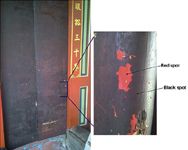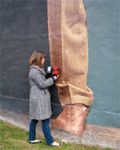Handheld FTIR Analysis for the Conservation and Restoration of Fine Art and Historical Objects
FTIR spectroscopy has long been used for the analysis of art and historical objects in support of efforts to conserve, restore, and validate authenticity of these rare objects. The value of the technique for this application lies in its inherent sensitivity, specificity, and non-destructive capabilities.
Alan Rein, Frank Higgins, and Pik Tang Leung, Agilent Technologies, Inc.
FTIR spectroscopy has long been used for the analysis of art and historical objects in support of efforts to conserve, restore, and validate authenticity of these rare objects. The value of the technique for this application lies in its inherent sensitivity, specificity, and non-destructive capabilities. Typical applications include analysis of paint pigments and binders, lacquers and finishes. FTIR can analyze the degree of oxidation of protective coatings used to protect objects, and the efficacy of those coatings. Measurement of chemical changes that result from aging is also a significant area of use for FTIR in support of art conservation efforts.
To date, virtually all FTIR spectrometers are located in labs and though the technique is non-destructive, the measurement often requires a small amount of the material of interest to be removed from the artifact. In order to ensure the minimum amount of damage to the object of interest, these samples are typically very small and often examined by microspectroscopic FTIR methods. This is positive, as only a small sample is required, but still the valuable object is being altered by sampling. Moreover, sampling such a small amount may not be representative of the chemical makeup of the larger area from which it has been removed. Furthermore, continuous monitoring of the restoration process is not desirable, as this would require a continuing sampling of the object, and thereby greater alteration.
Agilent 4100 ExoScan and 4200 FlexScan FTIR Analyzers
The availability of handheld FTIR analyzers such as the Agilent 4100 ExoScan and 4200 FlexScan FTIR systems is important for several reasons. Firstly, the FTIR analyzer is small enough and compact enough to bring the system directly to the object of interest whether it is located in a lab, on a museum floor, or at a field site. Secondly, no sample needs to be removed to analyze the object, and in fact, a number of areas on the object can be analyzed quickly in a truly non-destructive manner. Critical to getting useful information, the Agilent FTIR analyzers possess performance equivalent to that of traditional benchtop systems. This means that data obtained will be of high quality and information content.
Agilent Handheld FTIR Analyzers can:
- Analyze paintings, papers, documents and manuscripts, historical photographs, statuary, architecture, tapestries, tiles, mosaics, wood, and so forth.
- Be used at archaeological or historic sites where cave art, ceiling paintings, mosaic tiles or large immovable objects are located; that is, at sites where objects are too large or too valuable to send to a lab or to remove samples for lab analysis.
- Determine the identity of natural and synthetic organic and inorganic pigments, colorants and dyes, siccative binders, lacquers, resins, coatings, adhesives, fibers, and so forth.
- Determine the effect of aging, including damage caused by UV, thermal and environmental pollution.
- Support cleaning and restoration efforts of rare and historical objects.
- Identify counterfeit objects or objects that have been restored.
Application Examples
Some objects are too large and/or too historically significant to remove to a lab for analysis. Removing small samples from an object for lab analysis is not desirable, particularly if many areas on the artifact need to be investigated. For this reason, using a handheld FTIR analyzer at the object site is most valuable.

Figure 1
As an example, the 4100 ExoScan FTIR system equipped with Diffuse Reflectance sampling accessory was used to investigate the painted doors of the Beigans Chao-Tian temple doors in Taiwan (Figure 1).
The infrared spectra of the aged paint on these doors indicate differences in the amounts of oxalates, calcium carbonate, and cellulose present. The oxalates are a common by-product of micro-organisms such as fungi and algae that feed off of the paint, pigments, and cellulose and excrete oxalic acid, which can attack the paint pigments. The infrared spectra of a light red region of the doors shows little oxalate present, however a blackened region shows much higher levels of oxalate (Figure 2).

Figure 2
Analysis of a number of other spots on the painted doors showed different levels of oxalates, plus identified the major chemical components of the paint mixture including calcium carbonate, talc, kaolin clay, and cellulose. This was accomplished without removing samples, nor disturbing the artifacts.
2800 °C are compared to that of a clay fragment found at the site. The latter spectrum indicates that the pottery was fired at between 400 and 600 °C.
Major cities throughout the world encourage contemporary artists to paint remarkable murals on the sides of large buildings or structures. These cities are interested in preserving these murals, which are exposed to sunlight, pollution, and the elements. Organizations such as Rescue Public Murals! in the U.S. are actively involved in bringing public attention to murals, documenting their artistic and historic significance, and obtaining expertise and funding to preserve them.

Figure 3: The Agilent 4100 ExoScan FTIR will be used to evaluate the condition of the "Dr. J." mural to determine when recoating/restoration is required. Image courtesy of The City of Philadelphia Mural Arts Project and Amanda Norbutus, University of Delaware Preservation Studies Doctoral Program.
For example, the mural in Figure 3, entitled "Dr. J.", is located in Philadelphia, Pennsylvania, which has a significant collection of outdoor murals. In order to preserve this mural, as well as others, conservationists are exploring the use of various coatings that include UV stabilizers and other additives.
To do so they are carrying out accelerated aging experiments using coupons covered in various types and shades of paint that are typically used in outdoor murals. Different surface coatings are applied and then tested for their suitability for preserving these paints. FTIR spectroscopy is used to test the changes in both the paint and the coatings as a function of time — this is done by following changes in the carbonyl band (Figure 4) of the methacrylate-based polymer used as coatings. The plan is to use the 4100 ExoScan FTIR system to evaluate the condition of both the coating and the paint on the outdoor mural in order to determine its condition and when recoating/restoration is required.

Figure 4
Conclusion
FTIR spectroscopy is useful for a wide range of applications in the conservation and restoration of art and historical objects. With the availability of handheld FTIR analyzers such as the Agilent 4100 ExoScan and 4200 FlexScan FTIR systems, the spectrometer can be brought directly to the object to be analyzed.
Agilent Technologies, Inc.
2315 Stevens Creek Blvd., Santa Clara, CA 95052
tel. (800) 227-9770; Fax: (302) 633-8901
Website: www.agilent.com

Thermo Fisher Scientists Highlight the Latest Advances in Process Monitoring with Raman Spectroscopy
April 1st 2025In this exclusive Spectroscopy interview, John Richmond and Tom Dearing of Thermo Fisher Scientific discuss the company’s Raman technology and the latest trends for process monitoring across various applications.
A Seamless Trace Elemental Analysis Prescription for Quality Pharmaceuticals
March 31st 2025Quality assurance and quality control (QA/QC) are essential in pharmaceutical manufacturing to ensure compliance with standards like United States Pharmacopoeia <232> and ICH Q3D, as well as FDA regulations. Reliable and user-friendly testing solutions help QA/QC labs deliver precise trace elemental analyses while meeting throughput demands and data security requirements.